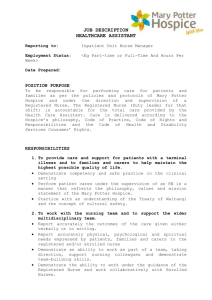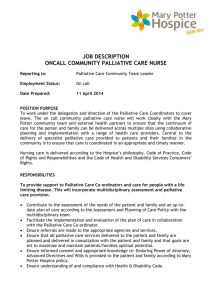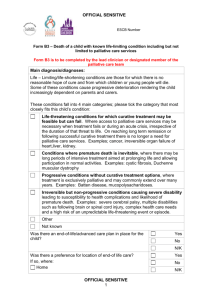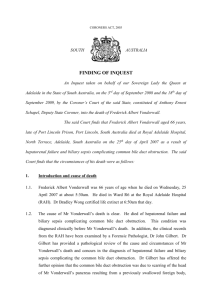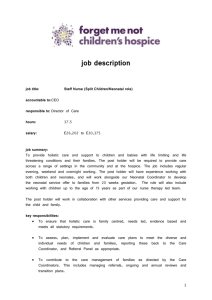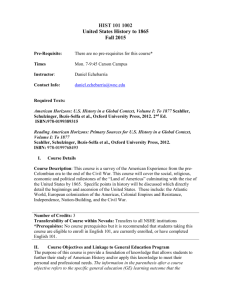CARDASSIS Andrew Paul
advertisement
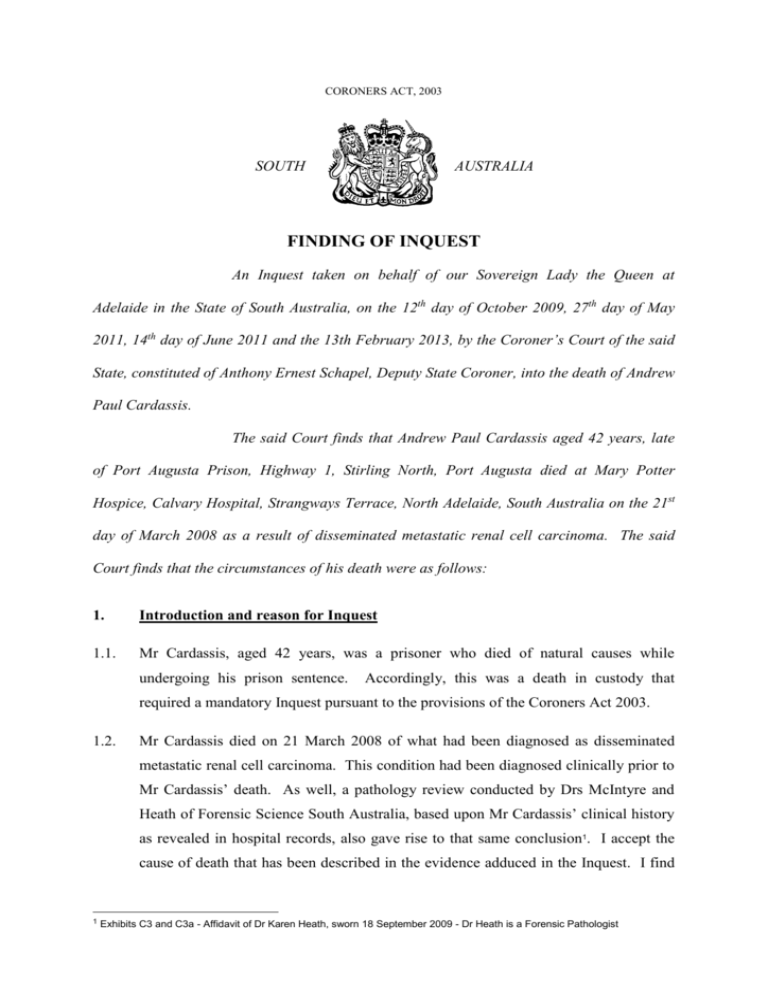
CORONERS ACT, 2003 SOUTH AUSTRALIA FINDING OF INQUEST An Inquest taken on behalf of our Sovereign Lady the Queen at Adelaide in the State of South Australia, on the 12th day of October 2009, 27th day of May 2011, 14th day of June 2011 and the 13th February 2013, by the Coroner’s Court of the said State, constituted of Anthony Ernest Schapel, Deputy State Coroner, into the death of Andrew Paul Cardassis. The said Court finds that Andrew Paul Cardassis aged 42 years, late of Port Augusta Prison, Highway 1, Stirling North, Port Augusta died at Mary Potter Hospice, Calvary Hospital, Strangways Terrace, North Adelaide, South Australia on the 21st day of March 2008 as a result of disseminated metastatic renal cell carcinoma. The said Court finds that the circumstances of his death were as follows: 1. Introduction and reason for Inquest 1.1. Mr Cardassis, aged 42 years, was a prisoner who died of natural causes while undergoing his prison sentence. Accordingly, this was a death in custody that required a mandatory Inquest pursuant to the provisions of the Coroners Act 2003. 1.2. Mr Cardassis died on 21 March 2008 of what had been diagnosed as disseminated metastatic renal cell carcinoma. This condition had been diagnosed clinically prior to Mr Cardassis’ death. As well, a pathology review conducted by Drs McIntyre and Heath of Forensic Science South Australia, based upon Mr Cardassis’ clinical history as revealed in hospital records, also gave rise to that same conclusion1. I accept the cause of death that has been described in the evidence adduced in the Inquest. I find 1 Exhibits C3 and C3a - Affidavit of Dr Karen Heath, sworn 18 September 2009 - Dr Heath is a Forensic Pathologist 2 that the cause of Mr Cardassis’ death was disseminated metastatic renal cell carcinoma. 1.3. The carcinoma was originally diagnosed within Mr Cardassis’ right kidney. In due course it metastasised to other parts of his body, including his lungs and his brain. 1.4. Mr Cardassis had been convicted of a number of sexual offences in 2006. He received a head sentence of 9 years and 8 months with a non-parole period of 6 years and 6 months. He was still undergoing that sentence when he died at the Mary Potter Hospice at Calvary North Adelaide Hospital. Mr Cardassis was incarcerated for the most part within the Port Augusta Prison. There is no suggestion other than Mr Cardassis’ incarceration was perfectly lawful and I so find. 2. Mr Cardassis’ diagnosis and decline 2.1. Mr Cardassis had no relevant medical history prior to his incarceration. 2.2. His medical history within South Australian correctional institutions dating from 2005 is described in the statement of Dr Peter Frost2. Dr Frost is a legally qualified medical practitioner. He is the Medical Director for the South Australian Prison Health Service. As I understand the position, Mr Cardassis had been remanded in custody for a period or periods prior to his trial which had concluded with the recording of a number of convictions in the District Court on 18 May 2006. On that day he was admitted to the Adelaide Remand Centre. Dr Frost states that on 6 September 2006 an ultrasound revealed a large renal mass in respect of Mr Cardassis’ right kidney. A CT scan conducted at the Royal Adelaide Hospital (RAH) on 28 September 2006 gave rise to the diagnosis of probable renal cancer. In the early hours of the morning of 1 December 2006, Mr Cardassis was admitted to the RAH Accident and Emergency Department due to pain. On 6 December 2006 Mr Cardassis underwent surgery which was of an exploratory nature but which ultimately involved the removal of what was believed to be cancer of the right kidney. On 18 December 2006 an histology report confirmed the existence of cancer that had extended into fatty tissue surrounding the kidney. No cancer was detected within Mr Cardassis’ lymph glands. 2 Exhibits C5 and C5a 3 2.3. Also on 18 December 2006 Mr Cardassis was discharged from the RAH and was then incarcerated within the Yatala Labour Prison. 2.4. In March 2007 it was revealed that there was metastatic disease in Mr Cardassis’ lungs. This in effect represents the spread of Mr Cardassis’ renal cancer to his lungs. Following this he received Sunitinib therapy but this was ceased when the disease was found by way of a CT scan to be progressing. He was known to have intrapulmonary disease on the right, with enlarged mediastinal lymph nodes, and compression of his right bronchus. He was being treated for pneumonia due to bronchial obstruction and plans were being made to administer radiotherapy to the lung as an outpatient. Mr Cardassis was discharged on 20 November 2007. 2.5. Mr Cardassis was readmitted to the RAH between 6 December and 17 December 2007 when he underwent drainage of a right pleural effusion and talc pleurodesis. 2.6. On 22 December 2007 Mr Cardassis was admitted to the RAH Medical Oncology Unit again with symptoms of shortness of breath and chest pain. During this admission he was informed that there were no further options for treatment with chemotherapy or radiotherapy at that time. In addition, due to ongoing difficulties in stabilising his pain and symptom management, he was transferred to the care of the Palliative Care Unit and moved to the Mary Potter Hospice, Calvary North Adelaide Hospital on 8 January 2008. From that point Mr Cardassis remained as an inpatient either within the Mary Potter Hospice or within the Palliative Care ward at the RAH. He had been transferred back to the Mary Potter Hospice on 17 March 2008 and remained there until his death four days later on 21 March 2008. 2.7. Dr Frost points out in his statement3 that, although technically a Department for Correctional Services prisoner, the deceased’s care from early January 2008 was managed within the Mary Potter Hospice environment. Dr Frost makes the following observation concerning Mr Cardassis’ treatment within the Prison Health Service: 'Prior to the ultrasound there were no symptoms or laboratory investigations suggesting a renal malignancy. I do not believe that his condition could have been detected any earlier than what it had been. I believe the initial operation was performed with curative intent but the histological findings of high grade malignancy with extension outside of the kidney were poor prognostic indicators. I further believe he received appropriate followup care at the RAH and there was nothing further that could have been done to prevent 3 Exhibit C5a, page 4 4 cancer recurrence and metastatic spread. Once metastatic disease appeared he received appropriate palliative treatment through to his death.' 4 2.8. The remaining weeks of Mr Cardassis’ life are described within the statement of Dr Mary Brooksbank who is the Director of the Palliative Care Unit at the RAH and Medical Director of Mary Potter Hospice at the Calvary North Adelaide Hospital5. She is a practitioner in palliative care medicine and her Department regularly receives referrals for assistance with palliative care for patients with a range of cancer diagnoses. Dr Brooksbank first met Mr Cardassis on 19 November 2007. At that time he was referred to the Palliative Care Unit at the RAH for advice on pain management whilst an inpatient in one of the other hospital wards. Dr Brooksbank states that following Mr Cardassis’ transfer to the Mary Potter Hospice on 8 January 2008, he remained as an inpatient there until 15 February 2008 when he was transferred back to the Palliative Care Ward at the RAH. In the intervening period he had ongoing difficulties with pain in his right chest, nausea, dyspnoea and, at times, drowsiness and confusion thought to be related to his medication. He was prescribed antidepressant medication for low mood. On 30 January 2008, twitching of Mr Cardassis’ right hand and arm led to a CT scan of his head being performed which revealed multiple cerebral metastases. Dexamethasone and anticonvulsant medication were commenced and he remained reasonably stable, although with increasing shortness of breath and other complications. Mr Cardassis also continued to experience shortness of breath and, in due course, scans revealed a pericardial effusion which was the reason he was transferred back to the RAH in mid February 2008. Mr Cardassis underwent pericardial draining within the RAH that secured relief from his shortness of breath. In this period he also received some radiotherapy to his brain. 2.9. On 25 February 2008 Mr Cardassis was transferred back to the Mary Potter Hospice for ongoing care but his symptoms of shortness of breath and leg oedema increased steadily. This led to consideration being given to further pericardial draining and this took place over a number of days within the RAH. The creation of a pericardial window to further relieve his symptoms was considered but, in the event, the risk of anaesthesia in his precarious state was too great and the procedure was discounted. 4 5 Exhibit C5a, page 5 Exhibit C2b 5 2.10. Mr Cardassis was transferred back to the Mary Potter Hospice on 17 March 2008 where he remained until his death. In that period of time he was administered analgesic medications which included morphine. There were other palliative medical measures adopted. 2.11. Mr Cardassis died at approximately 12:45pm on 21 March 2008. 2.12. Mr Cardassis’ medical treatment was reviewed by Professor Michael Brown who is a senior medical oncologist and Director of the Cancer Clinical Trials Unit at the RAH Cancer Centre. In addition he is a Clinical Professor of the School of Medicine at the University of Adelaide. Professor Brown provided a report to the Inquest. In his report Professor Brown provides a description of Mr Cardassis’ medical history insofar as it relates to his terminal illness. The only comment that he makes in respect of Mr Cardassis’ treatment is to observe that there was an apparent lack of timeliness in arranging Mr Cardassis’ urology review. He suggested that it was much later than would have been desirable for a putative diagnosis of localised renal cell carcinoma. However, he observes that the delay appeared not to result from any lack of effort on the part of the Prison Health Service medical staff and also observes that it is not clear whether the urology review would have been any more delayed for a prisoner than for a free citizen. I do not understand Professor Brown to be of the view that Mr Cardassis’ death could have been prevented by earlier surgical intervention. 3. Recommendations 3.1. I see no need to make any recommendation arising out of the circumstances of Mr Cardassis’ death. Key Words: Death in Custody In witness whereof the said Coroner has hereunto set and subscribed his hand and Seal the 13th day of February, 2013. Deputy State Coroner Inquest Number 31/2009 (0378/2008)
